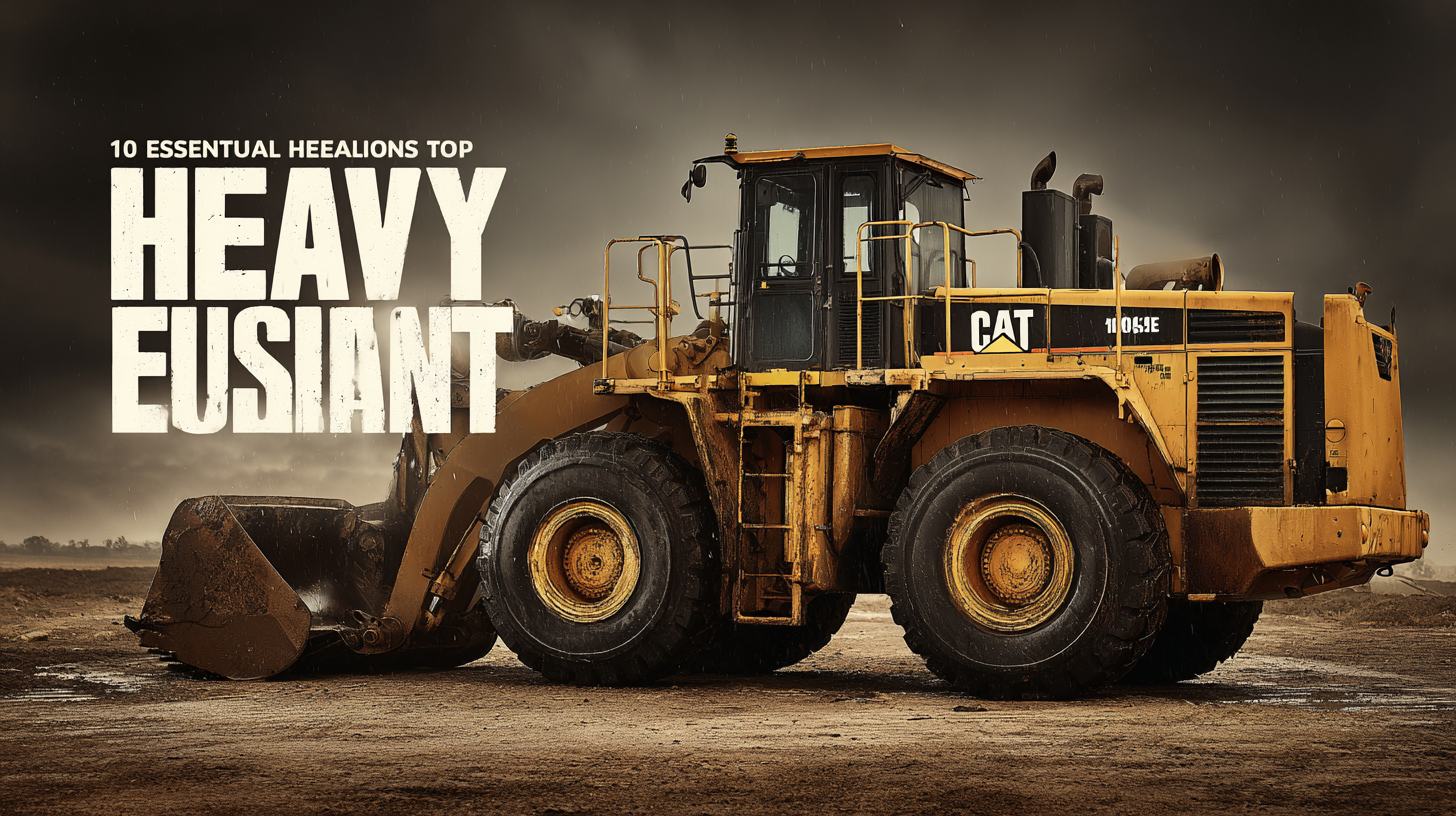Leave Your Message
- Phone
- E-mail
- Whatsapp
In today's global economy, sourcing the best heavy equipment is essential for businesses looking to enhance their operational efficiency and productivity. As industries expand, the demand for high-quality machinery continues to rise, making it imperative for companies to understand the nuances of international procurement. This blog will delve into 10 essential tips for sourcing heavy equipment worldwide, focusing on not only the selection process but also the critical importance of compliance with import and export certifications. By implementing these strategies, businesses can ensure that they acquire reliable and competitively priced machinery while navigating the complexities of global markets. Whether you are a seasoned buyer or just starting in the field, these insights will equip you with the knowledge needed to make informed decisions in sourcing heavy equipment.

As the global construction landscape evolves, the demand for heavy equipment is experiencing significant shifts. In particular, the Surface Mining Equipment market is projected to reach USD 103.10 billion by 2033, driven by a compound annual growth rate (CAGR) of 7.10%. This growth reflects the increasing need for efficient extraction methods in response to rising mineral requirements worldwide. Understanding the key markets for surface mining equipment is essential for stakeholders looking to capitalize on these trends.
Simultaneously, the heavy construction equipment industry is also set to expand, with projections indicating a market size of USD 289.3 billion by 2030, growing at a CAGR of 5.2%. This expansion is supported by a growing emphasis on infrastructure development and urbanization, which drives demand for advanced construction solutions. Additionally, the electric construction equipment sector is gaining momentum, with an expected growth rate of 25.72% through 2031, showcasing a clear shift towards sustainability and innovation within the industry. Identifying these key markets and understanding their growth dynamics will be crucial for informed sourcing decisions in the heavy equipment sector.
 When sourcing heavy equipment, it's crucial to evaluate supplier credentials thoroughly. One important aspect is their adherence to the National Highway Sector Schemes (NHSS) certification, which is essential for contractors and subcontractors aiming to work on the UK road network. Achieving NHSS certification signifies a supplier's commitment to quality management and safety standards, helping to ensure that the equipment used meets stringent industry requirements. According to recent industry reports, organizations with NHSS certification have been shown to reduce operational risks by up to 30%, highlighting its importance in maintaining safety and reliability.
When sourcing heavy equipment, it's crucial to evaluate supplier credentials thoroughly. One important aspect is their adherence to the National Highway Sector Schemes (NHSS) certification, which is essential for contractors and subcontractors aiming to work on the UK road network. Achieving NHSS certification signifies a supplier's commitment to quality management and safety standards, helping to ensure that the equipment used meets stringent industry requirements. According to recent industry reports, organizations with NHSS certification have been shown to reduce operational risks by up to 30%, highlighting its importance in maintaining safety and reliability.
In addition to NHSS, consider certifications like the ISA Certified Automation Professional (CAP) and Cyber Essentials, which reflect an organization’s dedication to quality and data security respectively. The CAP certification is particularly valuable in automation sectors, denoting a professional’s expertise and enhancing the credibility of the supplier. Meanwhile, Cyber Essentials helps safeguard sensitive data, ensuring that your projects are secure from potential cyber threats. When evaluating suppliers, prioritize those who demonstrate high levels of industry-recognized credentials, as this not only mitigates risk but also enhances overall project outcomes.
When sourcing suppliers, it’s beneficial to conduct comprehensive research using platforms that provide insights into a supplier’s certifications and past performance. Look for suppliers who are transparent about their compliance with industry standards and who can provide proof of certifications. Engaging with certified suppliers not only enhances project safety but also promotes an environment of trust and reliability in your sourcing strategy.
When sourcing heavy equipment globally, compliance with local regulations is paramount. Different countries and regions have specific requirements regarding safety standards, emissions, and operational guidelines. Understanding these regulations not only helps avoid legal complications but also ensures the equipment sourced meets the local market's expectations. For instance, some regions may prioritize sustainable and electric machinery given the rising emphasis on environmental concerns.
Additionally, as the global electric construction equipment market is projected to grow significantly from $12.04 billion in 2024 to $57.95 billion by 2032, awareness of regulatory landscapes becomes crucial. Companies looking to invest in heavy equipment must stay updated on evolving compliance needs to benefit from this growth. Engaging with local authorities and industry experts can provide valuable insights into the necessary certifications and standards, thus facilitating smoother entry into diverse markets. By prioritizing regulatory compliance, businesses can enhance their competitiveness in the burgeoning global equipment market.

When sourcing heavy equipment globally, assessing quality is paramount. Key performance indicators (KPIs) provide a useful framework to evaluate machinery effectively. Factors such as operational efficiency, fuel consumption, and maintenance costs serve as crucial KPIs. Analyzing these metrics allows buyers to gauge the equipment's productivity and long-term cost implications. For instance, a machine with lower fuel consumption may have a higher upfront cost but offers substantial savings over time, making it a better investment.
Durability metrics are equally essential in determining equipment quality. This includes understanding the materials used in construction, the manufacturer's reputation for longevity, and the equipment's performance in harsh conditions. For instance, abrasion resistance and load-bearing capacity can help predict how well the machinery will hold up under stress. Additionally, conducting inspections or seeking third-party assessments can provide deeper insights into durability, ensuring that the equipment not only meets current needs but is also built to last through demanding applications. When these factors are thoroughly evaluated, sourcing heavy equipment can lead to better outcomes and reduced risks.
In today’s competitive market, leveraging technology, especially data analytics, is crucial for making informed sourcing decisions for heavy equipment. According to a report by McKinsey, companies that incorporate data analytics into their procurement processes see a potential cost reduction of 5-10%. By analyzing trends, supplier performance, and market fluctuations, organizations can optimize their sourcing strategies, ensuring they acquire the best equipment at the most favorable prices.
Data analytics empowers procurement teams to make decisions based on real-time insights rather than gut feelings. For instance, using predictive analytics, firms can forecast demand fluctuations, allowing them to adjust sourcing strategies proactively. A study from Deloitte emphasizes that companies utilizing advanced analytics can improve their sourcing efficiency by up to 30%. This not only streamlines operations but also enhances collaboration with suppliers, fostering long-term relationships built on transparency and mutual benefit. By embracing technology and data-driven insights, companies can ultimately position themselves to source heavy equipment more effectively on a global scale.
